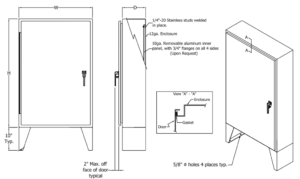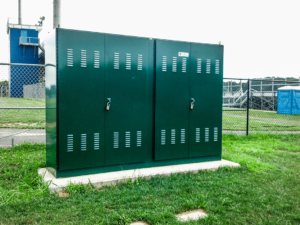 Utility companies deliver electric power for residential and business customers through a series of steps, including generation, transmission and distribution. Throughout the power grid, there are several key pieces of equipment that are often exposed directly to the weather or other site-specific conditions. Electrical enclosures accomplish two very important functions: they protect key equipment from conditions such as dust and moisture, while isolating the equipment itself from personnel.
Utility companies deliver electric power for residential and business customers through a series of steps, including generation, transmission and distribution. Throughout the power grid, there are several key pieces of equipment that are often exposed directly to the weather or other site-specific conditions. Electrical enclosures accomplish two very important functions: they protect key equipment from conditions such as dust and moisture, while isolating the equipment itself from personnel.
Monitoring and Control Equipment
In order to offer safe and continuous operation, a power grid requires monitoring and control measures. Power plants, substations and switchyards all include these systems, and the type of electrical enclosures used must ensure that the components inside are not damaged by dust, moisture, corrosion or other environmental factors.
Electrical enclosures for monitoring and protection equipment must also ensure that high-voltage components are isolated internally from low-voltage control circuits and relays. This allows maintenance personnel to service low-voltage equipment without exposure to transmission level voltages.
Switchgear
Switchgear carries out a critical function in any power grid: the disconnection of circuits in response to dangerous fault currents. Electrical faults involve currents with magnitudes of thousands of amperes, which can be lethal for humans and can cause severe damage to property and equipment. Keeping switchgear under optimal conditions is of paramount importance, and this is achieved in great part with the use of a suitable electrical enclosure.
Pad-Mounted Transformers
 Transformers are one of the cornerstones of any power grid, since they allow voltage to be stepped up and down to the optimal value for each step in the power transmission and distribution process. Pad-mounted are a special type that is installed on an equipment pad in the ground, hence its name, and where cables are connected to the transformer through an underground access.
Transformers are one of the cornerstones of any power grid, since they allow voltage to be stepped up and down to the optimal value for each step in the power transmission and distribution process. Pad-mounted are a special type that is installed on an equipment pad in the ground, hence its name, and where cables are connected to the transformer through an underground access.
These pieces of equipment normally have frontal doors: the enclosure must protect the internal connections from local conditions, while also serving as a safety measure for personnel.
Underground Enclosures
Although the majority of power lines are suspended in towers, at a safe distance from the ground, there are many locations in power grids where these lines must be taken to ground level for connection with transformers and protection equipment. Many of the associated connections are installed underground, and they may also include instrumentation – this requires a suitable electrical enclosure, capable of providing protection and electrical isolation.
Provisions for Future Expansion
When there are future expansion plans for electrical substations, it is necessary to leave primary cable loops of enough length to allow connection of new equipment. These cable loops require an electrical enclosure providing ease of access when the expansion project is executed, but which must also offer reliable protection for as long as the new equipment is not yet installed.
Other Utility Products
Power grids play a vital role in modern society, and their operation involves both high-voltage equipment and sensitive low-voltage components. In order for utility companies to operate safely and reliably, standardization is very important.
There are some applications where a specific enclosure is not directly available in the market, and custom metal fabrication may be required.